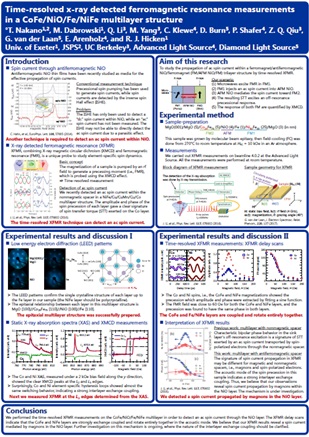
Time-resolved x-ray detected ferromagnetic resonance measurements in a CoFe/NiO/Fe/NiFe multilayer structure
T Nakano, M Dabrowski, Q Li, M. Yang, C Klewe, D.M. Burn, P Shafer, G van der Laan, Z Q Qiu, E Arenholz, and R J Hicken
IoP Magnetism Manchester Apr 2018
Antiferromagnetic NiO films have been studied as media for the effective propagation of spin currents [1]. In order to detect the ac spin current propagating through a NiO film, which has not been reported so far, we performed element-specific x-ray detected ferromagnetic resonance (XFMR) measurements [2] on a CoFe/NiO/Fe/NiFe multilayer.
Figure 1(a) shows the XFMR delay scans acquired at the Co and Ni L3 edges in the CoFe and NiFe layers respectively. The amplitudes and phases were extracted by fitting sine curves to the data acquired at different static magnetic fields, as shown in Figure 1(b) and (c). The FMR magnetic field was close to 60 Oe for both the CoFe and NiFe layers, and the precession was found to have the same phase in both layers. These unexpected results indicate that the CoFe and NiFe layers are strongly exchange coupled and rotate entirely together. An ac spin current could not be observed in this sample due to the exchange coupling. We suspect two possible origins for the coupling. Either the NiO layer contains oxygen deficiencies and metallic Ni components mediate the coupling, or else pinholes within the NiO layer allow the ferromagnetic layers to directly couple to each other.

Figure 1: (a) XFMR delay scans with a static magnetic field H of 60 Oe, (b) fitted amplitudes, and (c) fitted phases for Co (blue squares) and Ni (red circles) L3 edges. The sine curves in (a) are fits to the experimental data. 4-GHz microwaves were supplied through the coplanar waveguide (CPW) with a variable delay relative to the x-ray pulses, and generated an in-plane rf magnetic field orthogonal to the CPW, while H was parallel to the CPW.
[1] H. Wang et al., Phys. Rev. Lett. 113, 097202 (2014).
[2] J. Li et al., Phys. Rev. Lett. 117, 076602 (2016).